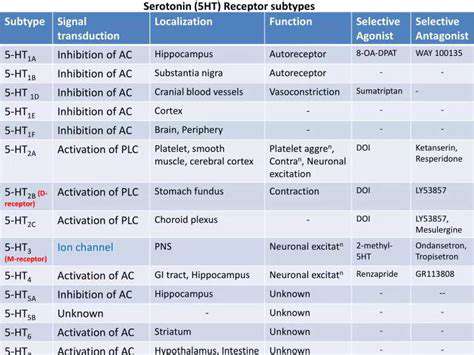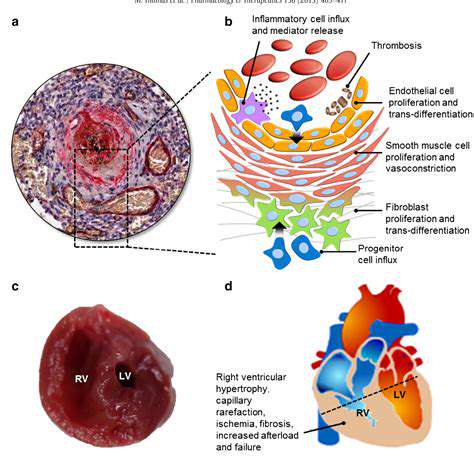Serotonin Synthesis and Storage
Within the intricate workings of our nervous system, the serotonergic system stands as a master regulator of numerous physiological processes. At its core lies the conversion of tryptophan, a humble amino acid, into the powerful neurotransmitter serotonin (5-HT). This biochemical transformation occurs predominantly within the raphe nuclei of the brainstem, where specialized neurons orchestrate this delicate dance of molecules. What makes this process particularly fascinating is its sensitivity to dietary factors and metabolic conditions, creating a direct link between what we eat and how our brain functions.
Following synthesis, serotonin molecules don't simply float freely within neurons. They're carefully packaged into synaptic vesicles - nature's version of precision delivery systems. This vesicular storage mechanism serves a critical purpose: it ensures that serotonin release occurs in controlled bursts rather than chaotic floods. Such meticulous regulation is absolutely vital for maintaining the delicate balance of neural communication. When this system falters, the consequences can ripple through the entire nervous system, potentially manifesting as various neurological conditions.
Serotonergic Pathways and Distribution
The reach of serotonin extends far beyond its production sites, with fibers fanning out like intricate highways throughout the central nervous system. These pathways don't just influence single functions; they create a complex web of interactions affecting everything from our emotional state to our perception of pain. The raphe nuclei serve as the central hub of this network, sending projections to diverse brain regions where serotonin exerts its multifaceted effects.
What's particularly remarkable about this distribution is how it enables serotonin to coordinate seemingly unrelated functions. The same neurotransmitter that helps regulate your mood at breakfast might be influencing your pain threshold by lunchtime. This widespread influence makes understanding serotonergic pathways crucial for developing targeted treatments for various conditions, including migraine disorders.
Serotonin Receptors and Their Functions
Serotonin doesn't act alone in producing its effects - it requires specialized docking stations called receptors. The human body has evolved an impressive array of these receptors, each type responding differently to serotonin's presence. This receptor diversity is nature's way of allowing one molecule to participate in countless physiological processes.
Some receptors act like volume knobs for pain signals, while others function more like mood thermostats. Certain receptor types help regulate our sleep-wake cycles, and others influence our digestive processes. This remarkable specialization explains why serotonin can wear so many different hats in our physiology. For researchers studying migraine pathophysiology, understanding these receptor subtypes offers promising avenues for developing more precise treatments.
Serotonin's Role in Migraine Pathophysiology
The connection between serotonin and migraine has become increasingly clear in recent years. When serotonergic signaling goes awry - whether through production issues, receptor malfunctions, or reuptake problems - the stage may be set for migraine attacks. This explains why medications targeting serotonin pathways, like triptans, have proven so effective for many migraine sufferers.
What remains particularly intriguing is how these serotonin disruptions actually trigger the cascade of events leading to migraine. Current research suggests it's not just about serotonin levels, but also about the timing and location of serotonin activity. As scientists continue to unravel these mechanisms, we're gaining valuable insights that could lead to even more effective migraine therapies.
Serotonergic System and Therapeutic Interventions
Given serotonin's central role in migraine, it's no surprise that many treatment strategies focus on modulating this system. Acute medications like triptans work by selectively targeting specific serotonin receptors to halt migraine attacks in progress. Meanwhile, preventive approaches often aim to stabilize serotonergic tone over the long term.
The ongoing exploration of the serotonergic system continues to yield exciting therapeutic possibilities. From novel receptor modulators to innovative delivery methods, researchers are developing increasingly sophisticated ways to harness serotonin's power for migraine relief. As our understanding deepens, so too does our ability to help those affected by this debilitating condition.
Serotonin Receptor Subtypes and Their Impact

Serotonin Receptor Subtypes: A Diverse Family
Serotonin's remarkable versatility stems from its ability to interact with multiple receptor types scattered throughout the body. These receptors aren't just passive switches - they're sophisticated molecular machines that translate serotonin's presence into specific cellular responses. This receptor diversity is what allows serotonin to participate in such a wide range of physiological processes, from regulating mood to controlling gut motility.
For clinicians and researchers, understanding these receptor subtypes is like acquiring a detailed map of serotonin's influence. Each receptor type represents a potential therapeutic target, offering opportunities to develop medications with increasingly precise effects. This specificity is crucial for maximizing therapeutic benefits while minimizing unwanted side effects.
5-HT1 Receptors: A Wide Range of Functions
The 5-HT1 receptor family serves as a prime example of nature's efficiency - one receptor class mediating multiple distinct functions. These receptors participate in everything from fine-tuning mood states to modulating how we perceive sensory information. Their presence in different brain regions allows them to influence diverse aspects of cognition and behavior.
Particularly noteworthy is the 5-HT1A subtype, often called the anxiety receptor for its role in stress responses. When activated, these receptors can produce calming effects, making them important targets for anxiety treatments. Other 5-HT1 subtypes contribute to processes like temperature regulation and cardiovascular function, demonstrating the far-reaching influence of this receptor family.
5-HT2 Receptors: Impact on Cognition and Behavior
The 5-HT2 receptor family operates like a master control panel for various cognitive and behavioral processes. These receptors help regulate everything from the vividness of our dreams to the intensity of our emotional responses. Their involvement in such fundamental processes makes them crucial players in mental health and neurological disorders.
In the realm of psychiatric treatment, 5-HT2 receptors have become important targets for medications addressing conditions like depression and schizophrenia. Some of the most effective antipsychotic medications work by precisely modulating activity at these receptors. Meanwhile, researchers continue to uncover new roles for these receptors in processes like learning and decision-making.
5-HT3 Receptors: A Focus on Nausea and Vomiting
Among serotonin receptors, the 5-HT3 subtype has carved out a very specific niche in controlling nausea and vomiting responses. Located primarily in the gut and certain brain areas, these receptors trigger protective reflexes when activated by serotonin. This mechanism explains why 5-HT3 blockers form the backbone of modern antiemetic therapy.
The clinical importance of these receptors became particularly evident with the development of chemotherapy-induced nausea treatments. By blocking 5-HT3 receptors, medications can prevent one of the most distressing side effects of cancer treatment. This success story highlights how understanding specific receptor subtypes can lead to dramatically improved patient care.
5-HT4 Receptors: A Role in Gastrointestinal Motility
Serotonin's influence extends well beyond the brain, with 5-HT4 receptors playing starring roles in digestive function. These receptors help coordinate the rhythmic contractions that move food through our gastrointestinal tract. When this system functions properly, we rarely notice its activity - but when it falters, the consequences can be quite uncomfortable.
The therapeutic potential of 5-HT4 receptors has led to medications for conditions like irritable bowel syndrome and chronic constipation. By carefully modulating these receptors, clinicians can help restore normal digestive rhythms. This represents another excellent example of how serotonin receptor research translates into real-world clinical benefits.
5-HT6 and 5-HT7 Receptors: Emerging Roles in Cognitive Function
The 5-HT6 and 5-HT7 receptor subtypes represent exciting frontiers in serotonin research. While less understood than their counterparts, these receptors appear to play important roles in higher cognitive functions. Early research suggests they may influence processes like memory formation and information processing speed.
What makes these receptors particularly intriguing is their potential relevance to neurodegenerative conditions. As researchers uncover more about their functions, we may see new treatments emerge for cognitive disorders. The unique distribution patterns of these receptors in brain regions associated with learning and memory further support their importance in cognitive health.
Cortisol, often called the stress hormone, serves as our body's built-in alarm system. Produced by the adrenal glands, this steroid hormone mobilizes energy reserves during challenging situations. While essential for survival, chronically elevated cortisol levels can wreak havoc on multiple body systems, contributing to conditions ranging from insomnia to impaired immune function.
Treatment Strategies Targeting Serotonin Pathways

Pharmacological Interventions
Modern medicine offers various pharmacological tools for modulating serotonin pathways. Among the most widely used are SSRIs (selective serotonin reuptake inhibitors), which gently increase serotonin availability in synaptic spaces. These medications have revolutionized the treatment of depression and anxiety disorders, offering relief to millions worldwide.
Choosing the right medication involves careful consideration of individual symptoms, medical history, and potential side effects. Some patients respond better to medications that target specific receptor subtypes, while others benefit from broader-acting agents. Regular follow-ups allow clinicians to fine-tune dosages and monitor for any adverse effects, ensuring optimal treatment outcomes.
Non-Pharmacological Therapies
Beyond medications, numerous evidence-based therapies can positively influence serotonin function. Cognitive Behavioral Therapy (CBT) stands out for its ability to reshape thought patterns that affect serotonin signaling. By identifying and modifying negative thought cycles, CBT can create lasting changes in brain chemistry and emotional well-being.
Mindfulness practices offer another powerful approach, helping to regulate stress responses that can disrupt serotonin balance. These techniques teach individuals to observe their thoughts and feelings without judgment, creating space for more balanced emotional responses. When combined with regular exercise - a proven serotonin booster - these approaches can significantly enhance mental health.
Lifestyle Modifications
Simple daily habits can powerfully influence serotonin function. A diet rich in tryptophan-containing foods (like turkey, eggs, and cheese) provides the raw materials for serotonin production. Regular exposure to natural sunlight helps maintain healthy serotonin rhythms, particularly for those prone to seasonal mood changes.
Perhaps most importantly, consistent sleep patterns help regulate the delicate balance of serotonin and other neurotransmitters. Establishing a calming bedtime routine and maintaining a regular sleep schedule can significantly impact overall neurotransmitter function. These lifestyle factors, while often overlooked, form the foundation for optimal serotonergic health.
Psychosocial Support
Human connection plays a surprisingly powerful role in serotonin function. Strong social bonds and supportive relationships naturally enhance serotonin activity, while isolation tends to diminish it. Support groups specifically for neurological conditions can provide both practical advice and emotional comfort.
Educating family members about serotonin-related conditions helps create more supportive home environments. When loved ones understand the biological basis of certain symptoms, they can offer more effective support. This combination of professional support and personal connection creates a powerful therapeutic network.
Complementary and Alternative Therapies
While research continues, some complementary approaches show promise for supporting serotonin function. Light therapy, for instance, can be particularly helpful for seasonal affective disorder. Certain forms of massage may temporarily boost serotonin levels, though effects are typically short-lived.
It's crucial to approach alternative therapies with both openness and caution. Always consult with a healthcare provider before trying new treatments, especially when combining them with medications. The most effective treatment plans often combine conventional and complementary approaches in carefully coordinated ways.